Tom's Guide Verdict
The Xperia X Performance lives up to its name and offers long battery life, but other high-end smartphones outshine it.
Pros
- +
Fast as any phone out there
- +
Excellent battery life
- +
Top-level camera
Cons
- -
Thick and slabby design
- -
Missing flagship features like a fingerprint reader and always-on screen
- -
Too much bloatware
Why you can trust Tom's Guide
The Xperia X Performance may be Sonyꞌs 2016 top-of-the-line phone, but you wouldnꞌt know that by looking at the devices. With the same display, casing and camera as the Xperia X, the Performance only separates itself from its sister device in its namesake category: performance.
Though the faster processor dropped inside this version of the Xperia X brings Sonyꞌs phone series up to speed with other 2016 Android flagship handsets, the high price tag puts the Performance among high-end smartphones where itꞌs largely out of its league.
Design: More slab for your buck
The Xperia X Performance comes packed in the identical metal casing as the Xperia X, right down to the same four color options. There is one difference, though: the Performance is thicker and, by virtue, heavier. The girth and weight differences between the standard and high-end Xperia Xs are small — at 0.33 inches and 5.8 ounces, the Performance is 0.02 inches thicker and 0.5 ounces heavier, respectively — but the added heft does kick the Performance beyond the bounds of the slim-feeling 5.36-ounce Samsung Galaxy S7. Itꞌs a difference that you can feel when holding both phones, exaggerated by the S7ꞌs tapered-off rear edges — a trick Sony should have considered implementing on its ho-hum and very rectangle Xperia phones.
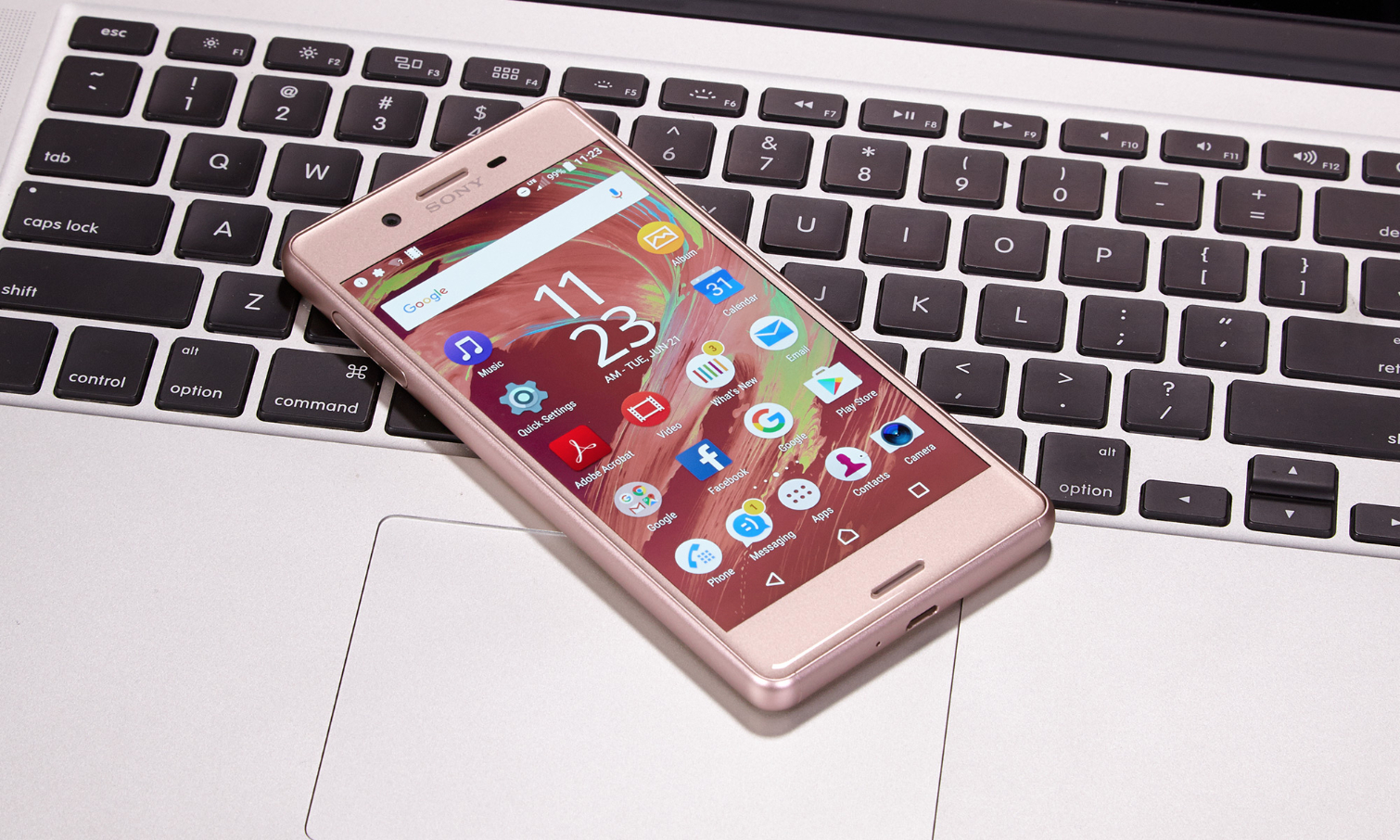
Beyond the Xperia X Performanceꞌs increased slabbiness and the addition of water resistance, the phone’s construction is vexing and pleasing in all the same ways the Xperia X is. Thereꞌs no camera bump on the back of the phone (take that iPhone and Galaxy), but the indented power button and awkwardly placed volume buttons are maddening. The handsetꞌs unicolor appearance is satisfying, but its top and bottom bezels make it taller than a medium-size phone should be.

All of Sonyꞌs Xperia X phones feature the now-outmoded micro USB port. Other 2016 flagship smartphones from LG, OnePlus and Google all sport USB Type-C, the new, canꞌt-plug-it-in-the-wrong-way universal standard in smartphone charging. Samsungꞌs newly released S7 and S7 edge phones also rock micro USB ports, though only to ensure compatibility with the companyꞌs gaining-in-popularity Gear VR headset. Sony has no such excuse for eschewing the future in USB.
The top-of-the-line Snapdragon 820 quad-core processor inside the X Performance is what really sets it apart from the Xperia X.
Like the Xperia X, the X Performance also lacks a fingerprint sensor. I am not going to argue thatꞌs the most important component on a phone, but in 2016, it has become an expected option on almost any handset, budget or high-end. (Even the $399 OnePlus 3 has a fingerprint sensor.) Sonyꞌs pitch for the Xperia X Performance over the Xperia X could have been a bit stronger with the addition of this bit of hardware.
MORE: Best Smartphones on the Market Now
Get instant access to breaking news, the hottest reviews, great deals and helpful tips.
Performance: An aptly named phone!
The top-of-the-line Snapdragon 820 quad-core processor inside the X Performance is what really sets it apart from the Xperia X, which carries a less capable Snapdragon 650. The 820 is the successor to the 810 powering the Nexus 6p and the same chip at the center of the Galaxy S7 and the LG G5. Though the Performance packs one fewer gigabyte of RAM than the latest LG and Samsung superphones (which both offer 4GB), that shortcoming was hard to detect in practice.
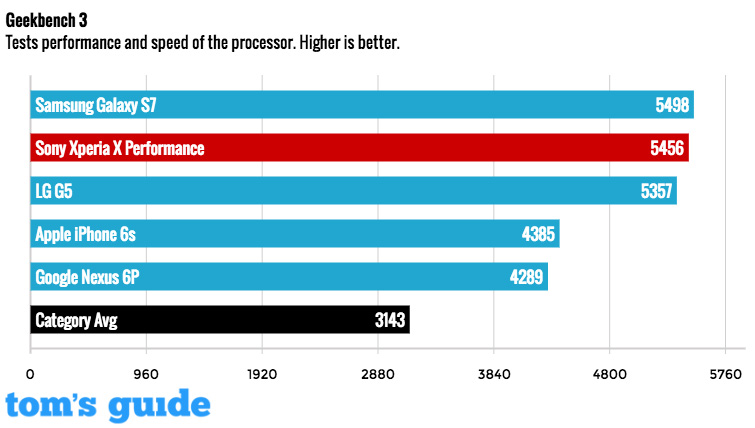
With a score of 5,456 in the Geekbench test, the Performance either beat or just about met the speed of the Galaxy S7 (5,498), the iPhone 6s (4,385), the LG G5 (5,357) and the Nexus 6p (4,289).
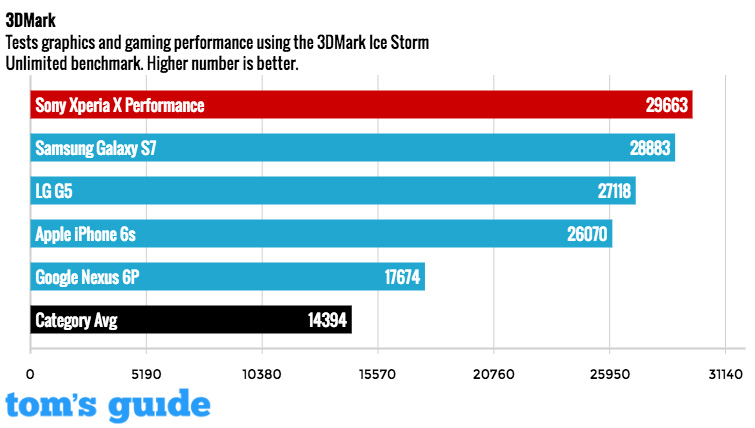
The phone also pulled in a 3DMark graphics score of 29,663, topping all handsets in its category and doubling the category average score of 14,586.
Put into practice, the X Performance was able fire up an Adobe Reader PDF in 7 seconds (2 seconds faster than the mighty Nexus 6p) and convert a 240MB video from 1080p to 480p in 3 minutes and 56 seconds (slightly faster than the S7, which handled the same task in 4:30.)
The indented power button and awkwardly placed volume buttons are maddening.
Google Maps grabbed turn-by-turn directions on the X Performance about as fast as Iꞌve seen on any phone, and your thumbs will be happy to hear that Temple Run-like game Subway Surf plays flawlessly with plenty of Chrome tabs open in the background.
Camera: A carbon copy of the Xperia X shooter – and thatꞌs good
Like the Xperia X, the X Performance comes with a pretty great set of cameras — in fact, the same exact 23-megapixel rear camera and 13-MP front shooter found on the Xperia X.

Although Sonyꞌs Xperia X takes pretty solid digital photos, itꞌs a shame that Sony didnꞌt boost the low-light capabilities of the sensor in the Performance in an effort to chase down smartphone camera King of the Hill Samsung.

Of course, if the phone in my pocket takes pictures like the one I took of some red flowers, youꞌre not going to get a lot of complaints out of me. The sharpness and intensity of the astilbe at the center of the close-up shot (on the right) are super-impressive.

Scenic comparison pics between the X Performance and the Galaxy S7 show hotter whites and slightly more noise in the Sony camera.

And when I took the two devices into my unlit basement to test low-light capabilities, the S7 proved itself far more capable than the Performance, though neither phone managed to grab a great-looking shot.

The front camera on the Performance takes negligibly similar grabs to the one on the S7 — in well-lit scenes, anyhow. A nighttime selfie from the Performance was woefully lacking in detail, though still good enough to let my Facebook friends in on the fun Saturday evening I was having.
Like the Xperia X, the X Performance has a physical camera button that both acts as a shutter button and launches the camera app right from a screen-off sleep state. I found myself using the latter button a lot.
Display and Audio: OK screen, subpar speakers
The 5-inch, 1080p display panel on the X Performance is less sharp than the Galaxy S7ꞌs 5.1-inch, 2560 x 1440 AMOLED panel, but the Sony produces truer colors than Samsungꞌs darling. Having a sharper pixel rating only means so much when your reds look orange and your whites look blue. (I know the exact shade of red in which my ESPN app is supposed to appear, and the X Performance nails it.) Our test results backed up my impressions, as the Performance notched a Delta-E rating of 0.48 (zero is perfect); the S7 registered 3.52.

The X Performance’s display is also quite bright — we recorded 555 nits of brightness with a light meter, compared with 437 nits for the average phone. Coming over from my 5.2-inch Nexus 5x, though, I felt a little cramped when trying to punch out text messages on Sonyꞌs phone. And unlike Samsung or LG, Sony didnꞌt try its hand at any kind of always-on display here — a truly useful feature that, even when the phone is asleep, presents simple things like the time or calendar info on the screen.
While the camera takes pretty solid digital photos, itꞌs a shame that Sony didnꞌt up the low-light capabilities of the sensor.
Practically speaking, I can say that watching HD YouTube videos on the Performance was fine — but listening to them through the phoneꞌs speakers was not. The phoneꞌs tinny, over-bassy speakers produce sound that annoyingly vibrates the back of the phone and often muddies up music. Youꞌd expect something a little better from the company that invented the Walkman.
MORE: Smartphones with the Longest Battery Life
Battery Life: A whole lot of win
The more powerful version of the X outpaces most of its competition when it comes to battery life.

The Performance gets only a slight bump in battery size over its sister handset — a 2,700-mAh battery compared with the Xꞌs 2,620-mAh — but it manages to do a lot with it, thanks to some of the smart-battery technology Sony has built into the Xperia X line.
The one piece of software that comes with the phone and is worth keeping – for gamers, anyway – is the PlayStation app.
The Tomꞌs Guide 4G LTE web-surfing test (on T-Mobileꞌs network) yielded a solid 12 hours, 1 minute of use on a single charge for the X Performance. That’s only 20 or so minutes off the market-leading Nexus 6p, and an improvement on the standard Xperia Xꞌs time of 9:10. This battery endurance easily trumps the iPhone 6s (less than 7 hours of use on a charge) and the Galaxy S7 (8:43).
Software and Apps: Why are phone makers still retooling Android system apps?
As a lover of phones that run untouched (or nearly untouched) Android, I can appreciate Sonyꞌs very softly modified build of Marshmallow. Unlike the hijacked version of Android that comes on Samsung or LG handsets, the true Google design is left intact in places like the pulldown notification window and in settings menus here, and it looks great.
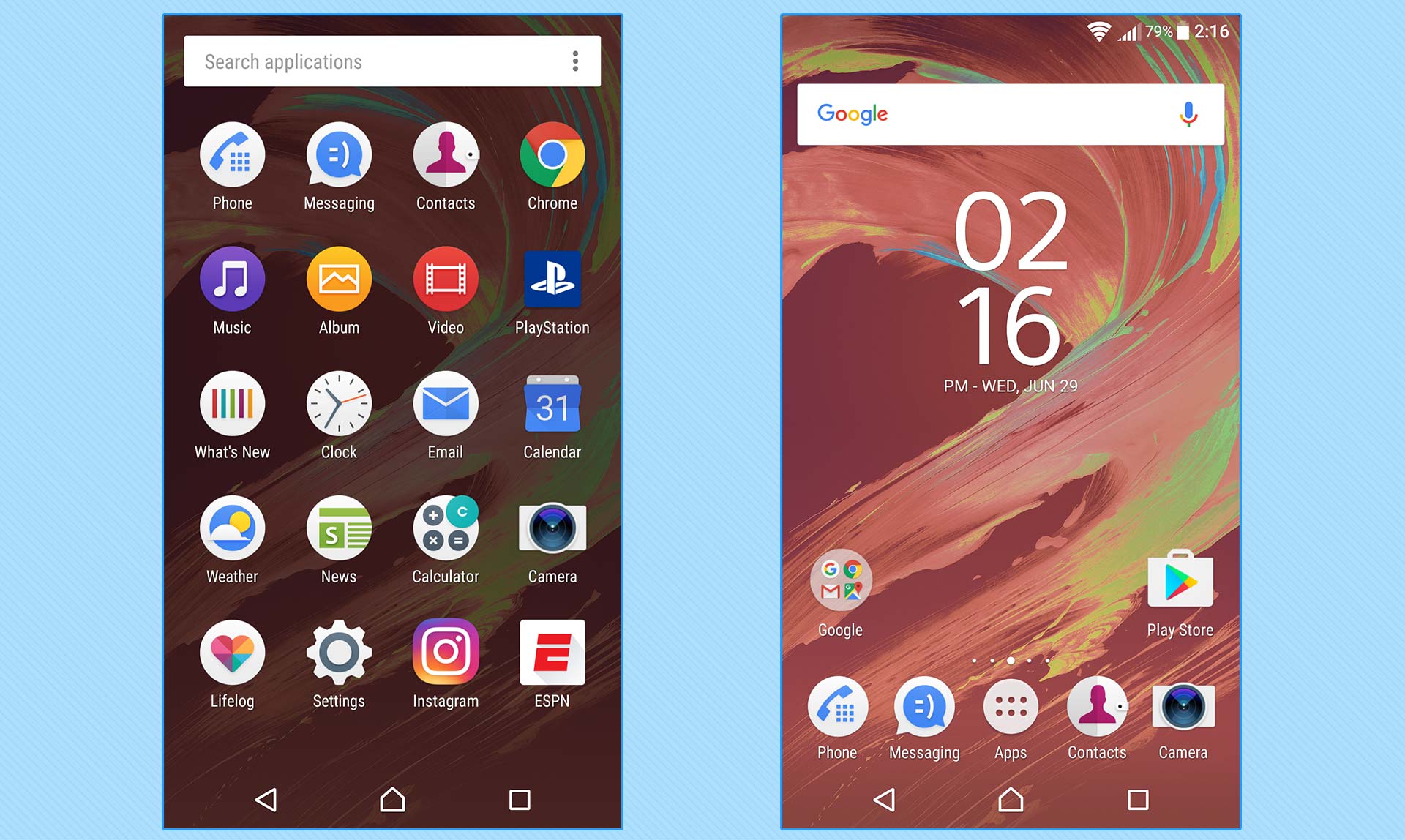
Whatꞌs more, most of the small changes Sony has implemented — the tweaked on-screen system buttons, the sideways-sliding lock screen, and the reorganizable app drawer — are either nice touches or things I can easily ignore.
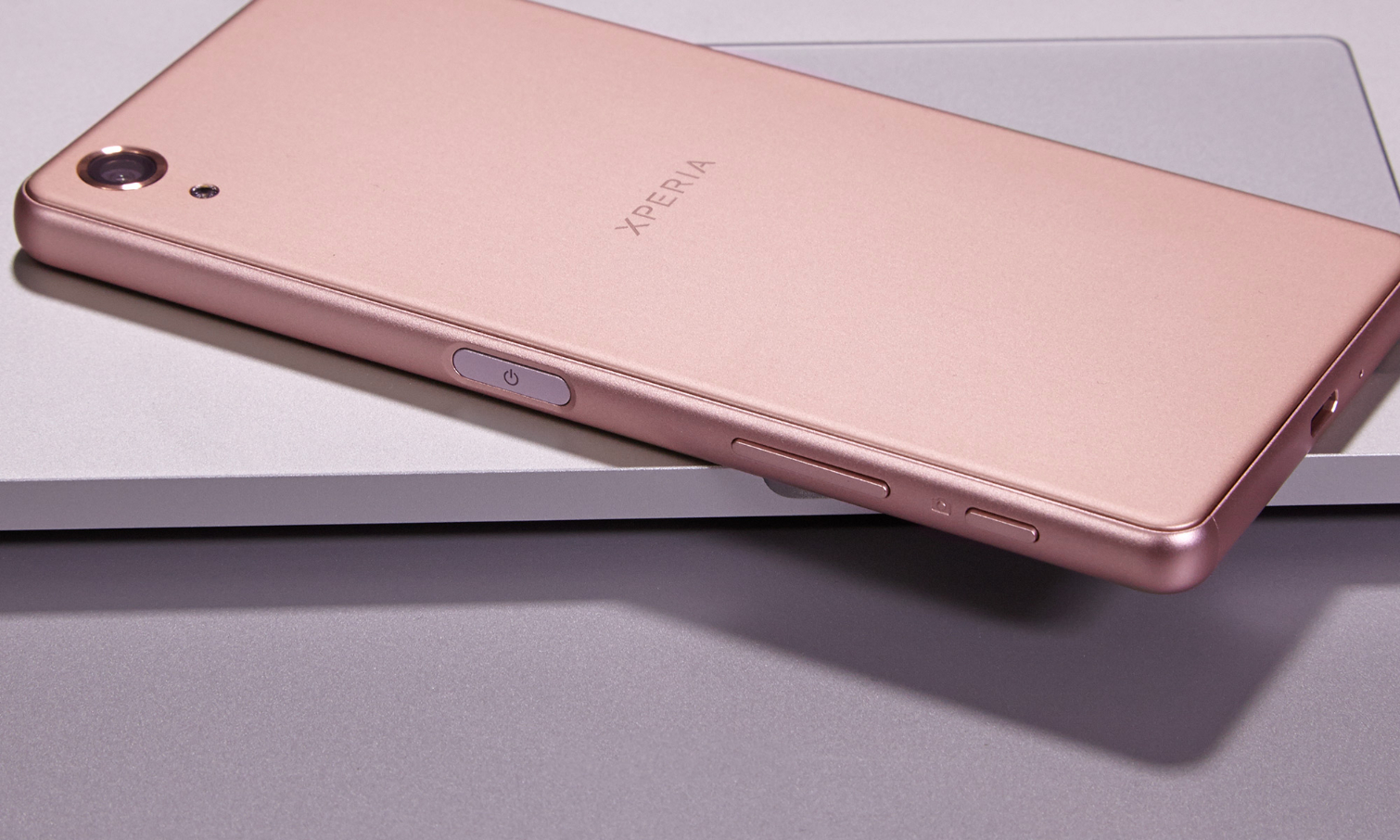
However, I ultimately wound up crying for my Nexus the moment I realized that the new Xperia phones are, for some reason, packed with Sonyꞌs own take on system apps like Messages, Clock, Contacts and Music. I really dislike typical smartphone bloatware — one example here is the Xperia Lounge app, which is essentially a portal to watch YouTube videos — but I can at least understand a shameless attempt to pipe in desired content to phone buyers. The need for phone makers to (poorly) replicate and (unfortunately) replace core apps that Google has already built for Android — that is something Iꞌll never understand.
With my aversion to bloatware, naturally I took the Performance to the cleaners by disabling and/or uninstalling all the preinstalled Sony apps that I could, and I would suggest anyone else who winds up owning this phone to do the same. The one piece of software that comes with the phone and is worth keeping — for gamers, anyway — is the PlayStation app. It offers an Xperia-exclusive way to remotely play PlayStation 4 games on your phone, so long as you have a wireless PS4 controller to hook it up to and are connected to the same Wi-Fi network as your console.
Bottom Line
The Xperia X Performanceꞌs price tag invites comparisons to other phones in that lofty price range — the iPhone 6s and, arguably, the best Android handset ever made in the Samsung Galaxy S7. Sonyꞌs offering canꞌt match the stylish design of those smartphones, and its camera, while capable, comes up short when compared to what the S7 can do (especially in low light). The one area where Sonyꞌs Performance handily beats out most of its competition — battery life — is hardly a scale-tipper.
Unlike the Xperia X, which is a borderline budget phone underdog that can just about hang with the big boys, the even more capable X Performance is clearly picking a fight with the best phones on the block. But after scratching my head over this device for a number of days, I don’t recommend it over the top 2016 handsets — unless you’re really dying to play PS4 games remotely on your smartphone.
Daniel Bean is a freelance writer with years of experience whose articles have appeared in Tom's Guide. He has previously worked for LinkedIn, Yahoo News, and the Observer, as well as TripleByte, Circa, Inverse, CBS, and ABC. Currently, he is full-time content lead for Mixpanel's blog, The Signal, writing about innovators and analytics.
-
Bdnzor Umm I have one and it has a fingerprint sensor in the power button, is that a different version without or did you just miss it?Reply
